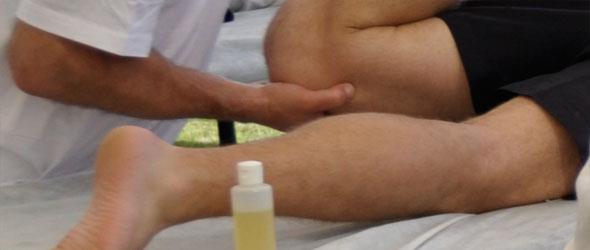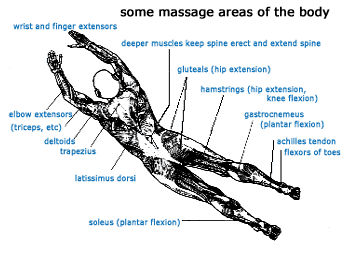Massage is defined as the systematic manipulation of the soft tissue of the body. The movements of gliding, compressing, stretching, percussing, and vibrating are regulated to produce specific responses in the athlete. Historically, wherever sports have been taken seriously, massage has been used in some form. Today sports massage is gaining popularity
Sports Massage
Sports massage has mechanical, physiological, and psychological responses.
Mechanical responses: Mechanical responses occur as a result of the pressures and movements of the hand on the body. These actions stimulate venous and lymphatic drainage and mildly stretch superficial and scar tissue. With friction massage connective tissue can be effectively stretched, helping prevent rigidity in scar formation. By the use of certain massage techniques; an athlete inactive due to injury or swelling surrounding a joint, stagnation of circulation may be prevented.
Physiological responses Massage is known to increase circulation and as a result increase metabolism to the musculature and aid in the removal of metabolites such as lactic acid, resulting in the offsetting of muscle soreness and fatigue. It also assists in offsetting venostasis and edema by increasing circulation at and around the injury site, as well contributing in the normal venous blood return to the heart. The reflex effects of massage are processes that, in reaction to nerve impulses triggered through rubbing the body, are sent to one organ by afferent nerve fibres and returned to another organ by efferent fibres. Reflex responses elicit a number of organ reactions namely body relaxation, stimulation, and increased circulation.Relaxation can be achieved by slow, superficial stroking of the skin. It is a type of massage that is beneficial for tense, anxious athletes who may require gentle treatment.
Stimulation is achieved by quick, brisk action that causes a contraction of superficial tissue. The benefits derived by the athlete are predominantly psychological. He or she feels invigorated after intense manipulation of the tissue. This type of massage was part of warm-up routine in the past, however it is less popular due to the time involved and the knowledge that it is relatively ineffectual physiologically.
An overall improvement in circulation is achieved with mechanical and reflex stimuli. Combined they cause the capillaries to dilate and be drained of fluid as a result of firm outside pressure, thus stimulating cell metabolism, eliminating toxins, and increasing lymphatic and venous circulation. This assists the healing process.
Psychological responses: The tactile system (the use of touch) is one of the most sensitive systems in the human organism. From earliest infancy humans respond psychologically to being touched.
Massage lubricants: To enable the hands to slide easily over the body, a friction-reducing medium must be used. Rubbing the dry body can cause gross skin irritation by tearing and breaking off the hair. Many mediums (e.g. fine powders, oil liniments, or almost any substance having a petroleum base) can be used to advantage as lubricants.
Positioning of the athlete: Proper positioning for massage is of great importance. The injured part must be easily accessible; the athlete must be comfortable, and the part to be massaged must be relaxed.
|view effective massage |
Confidence Lack of confidence on the part of the person doing the massage is easily transmitted through inexperienced hands. Every effort should be made to think of the procedure to be used and to present a confident appearance to the athlete.






















